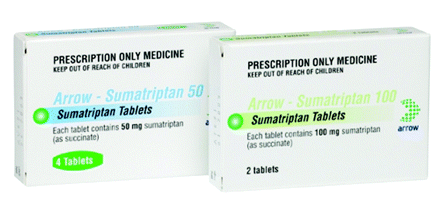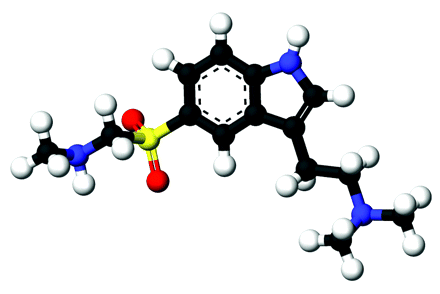Therapeutic Windows
Sumatriptan
The discovery and development of the triptans was recently judged by the membership of the American Headache Society to be the most important breakthrough in headache medicine in the last fifty years. In addition, this research, into sumatriptan in particular, coincided with early distinction of serotonin receptor subtypes.

Discovery
Research into the mechanisms of migraine was pioneered by US scientist Harold G. Wolff, MD (1898–1962). Using electrical stimulation in awake humans, he showed that the meninges, rather than brain parenchyma, were the source of headache pain. He demonstrated that pulsations of the superficial temporal artery correlated with headache duration and could be significantly reduced by ergotamine therapy. These observations led Wolff to propose migraine as a vascular disease in which pain results from meningeal blood vessel dilatation. The development of sumatriptan, the first block-buster drug to treat migraine, is a story that spans the globe and several decades, linking research efforts in the US, Australia, and Europe. The first of the 5-HT1B/1D agonist antimigraine drugs, sumatriptan came out of a discovery program that began in the UK, at Glaxo, in 1972. The architect of important therapeutic advances that culminated in this drug was Patrick Humphrey, a skeletal muscle electrophysiologist by training. The discovery of sumatriptan, a molecule remarkably similar in structure to serotonin, is an excellent example of reverse translation, whereby astute clinical observations informed the design of ground-breaking laboratory work that revolutionized the pharmacotherapy of migraine. RH

Indicated Uses
-
acute treatment of migraine attacks (with or without aura*)
-
acute treatment of cluster headache episodes

Richard Hargreaves Reminiscesa
Upon joining Glaxo in 1972, at the Ware site, in Hertfordshire, Patrick Humphrey was challenged by Research Director David Jack (subsequently, Sir David Jack CBE FRS FRSE) to discover a drug to treat migraine. To achieve this lofty goal, Humphrey was given an empty lab and one graduate assistant! Humphrey’s lab grew through the 1970s and early 1980s to include Wasyl Feniuk, Helen Connor, David Beattie, and others.
Humphrey not only acquainted himself with Wolff’s pioneering observations (see Discovery box), but also became intrigued by the ongoing work of James Lance and colleagues, in Australia. Lance’s group published a clinical study showing that methysergide was more effective than other 5-HT receptor antagonists in preventing migraine attacks, and they confirmed studies by Kimball and US colleagues that showed that vasoconstrictors such as serotonin could abort a migraine attack. In discussions with Lance, Humphrey discovered that methysergide could also give migraine headache relief acutely. Humphrey reasoned that the polar nature of serotonin would likely prevent the small molecule from crossing the blood brain barrier, and he thus hypothesized that serotonin acted outside the brain to constrict dilated blood vessels.
Additional experiments that caught Humphrey’s attention were also coming out of Rotterdam, where Pramod Saxena discovered that methysergide produced the highly selective constriction of arteriovenous anastomoses (predominantly in the cerebral circulation) without systemic cardiovascular effects. Pat Humphrey linked this observation to the rather unpopular “carotid shunt” theory of migraine. This theory, proposed by Hecyck, in 1981, was based on increased oxygenation observed in external jugular venous blood ipsilateral to headache, taken to imply unilateral opening of arterial shunts. Humphrey and Feniuk went to the Saxena lab in Erasmus, and using microsphere techniques, they found sumatriptan prototypes to be highly selective for cranial vascular beds, which was unlike the generalized vasoconstrictor activity of ergotamine.
Returning to their lab at Glaxo, Humphrey and Feniuk pursued in vivo hemodynamic flow studies that led to the discovery of sumatriptan. Through in vitro methods, they found that the selective cranial vasoconstriction appeared to be mediated by a novel “5-HT1-like receptor,” located on vascular smooth muscle. Humphrey and colleagues proposed that an agonist selective for this novel 5-HT1-like receptor would constrict cranial blood vessels and relieve migraine without causing peripheral effects. It was not known at that time that there are five 5-HT1 receptor subtypes in a family of fourteen receptor and ion channels!
Sumatriptan was the first drug of a revolution in treating migraine. Its SC injectable formulation remains unique and still provides the most rapid migraine relief of any triptan today. Pat Humphrey credits German physicians Doenicke and Brand, who clinically investigated the sumatriptan prototypes, with discovering the anti-migraine efficacy of the triptan profile. In 1991, Jes Olesen and colleagues in Denmark showed that sumatriptan increased blood velocity (indicative of a vasoconstrictor action) concomitant with migraine headache relief without affecting blood flow in the middle cerebral arteries. Despite much competition from several pharmaceutical companies, sumatriptan nevertheless sustained its leading market position by increasing the range of oral doses available and adding alternate delivery options (nasal spray).
While the pharmacology and physiology of sumatriptan was being unraveled, the molecular classification of serotonin receptors was underway. Sumatriptan is now recognized as an agonist at 5-HT1B receptors that reside on the smooth muscle of the meningeal arteries and mediate vasoconstriction; it is also an agonist of the inhibitory 5-HT1D receptors on peripheral and central ends of the trigeminal nerves, preventing the release of pro-inflammatory sensory neuropeptides (e.g., CGRP) in the meninges and nociceptive signal transmission centrally in the trigeminal pain pathways. Interestingly, sumatriptan also has activity at inhibitory central 5-HT1F receptors in the trigeminal pain pathway. The potential role of central 5-HT1B receptors in the effectiveness of sumatriptan remains an enigma to this day.
Humphrey was recognized for his drug discovery work and his contribution to human health with the award of an Order of the British Empire from Queen Elizabeth. On a personal note, he has often told the story of how he discovered that his own wife’s headaches were menstrual migraines as they were treated well by sumatriptan. He also comments that he has often been politely and warmly kissed by many more women than he ever would have been in his life had he not discovered the drug!
On the market
First registration and launch was in the Netherlands in 1991. Sumatriptan became available in the USA in 1993.

Ins and Outs
The elimination half-life of sumatriptan is approximately two hours (regardless of whether administration is nasal or subcutaneous). A trial of twenty female volunteers established a mean Cmax of 5 ng/mL following a 5-mg intranasal dose.
-
Sumatriptan plasma levels may double in response to administration of MAO-A inhibitors.
-
Sumatriptan should not be co-administered with ergot-type medications or other 5-HT1 agonist (e.g., other triptans).
-
Sumatriptan treatment may preclude administration of antidepressants of the SSRI type.o
The Perplexity of Migraine
There has been a series of legendary debates at international symposia and in the literature, notably among Humphrey, Goadsby, and Moskowitz, concerning the relative virtues of the peripheral and central hypotheses of migraine genesis. Controversy around which of these actions is most important for the anti-migraine effectiveness of the triptans persists. Most likely, multiple sites of action are relevant to their antimigraine action. In order to test whether sumatriptan had neuronal actions that could be responsible for its anti-migraine effectiveness, several laboratories have used pharmacological models to examine the effects of sumatriptan on the trigeminovascular nociceptive system. [See (1).]

Moskowitz suggested that the release of proinflammatory mediators and neuropeptides such as substance P and CGRP activated the trigeminal sensory nerves to cause migraine pain. More than a decade ago, Peter Goadsby and Lars Edvinsson showed that CGRP but not substance P was elevated in external jugular venous blood during an attack and normalized by successful sumatriptan treatment; they thus suggested that CGRP and not substance P had a pathophysiological role. In the Merck laboratories, David Williamson with Richard Hargreaves discovered that trigeminally evoked neurogenic vasodilatation of the middle meningeal artery was mediated by CGRP release and could be blocked by sumatriptan. Goadsby additionally found the central effects of sumatriptan in preventing trigeminal pain signal transmission and the activation of second order sensory neurons in trigeminal nucleus caudalis. Multiple mechanistic studies have ensued.
Removal of the vasoconstrictor 5-HT1B component of action from drug candidates became a high priority for the pharmaceutical industry to test the neuronal hypotheses. There were also cardiovascular safety concerns with the triptan class as it was shown that vasoconstrictor 5-HT1B receptors, albeit at low density, were also present in the coronary blood vessels. A 5-HT1D selective partial agonist was tested by Upjohn but failed against migraine. Lilly tested 5-HT1F agonists that lacked vasoconstrictor activity and showed them to be effective against migraine, suggesting that vasoconstriction was not essential, but the chemical series was abandoned after toxicological studies.
Current clinical trials with CGRP receptor antagonists that have the potential to act both in the meningeal vasculature and centrally within the brain stem trigeminal dorsal horn may shed more light on the importance of the role of vascular CGRP-mediated vasodilatation compared to the neuronal hypothesis of migraine pain. By using target engagement markers (e.g., PET ligands), it will be possible to examine whether central sites are occupied at clinically effective anti-migraine doses of CGRP receptor antagonists and if clinical efficacy can be improved by engaging these central CGRP receptors. RH

Footnotes
-
↵* Aura refers to the sensory disturbance (e.g., sensation of light) that may typically precede attacks in some migraineurs.
-
↵a This commentary on the history of sumatriptan and its development draws on several publications from Pat Humphrey (2–4).
-
↵o These and other precautions that are essential to appropriate sumatriptan treatment can be found at the National Library of Medicine’s DailyMed Web site (http://dailymed.nlm.nih.gov).
- Copyright © 2010




